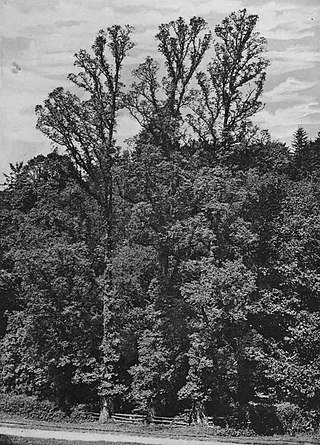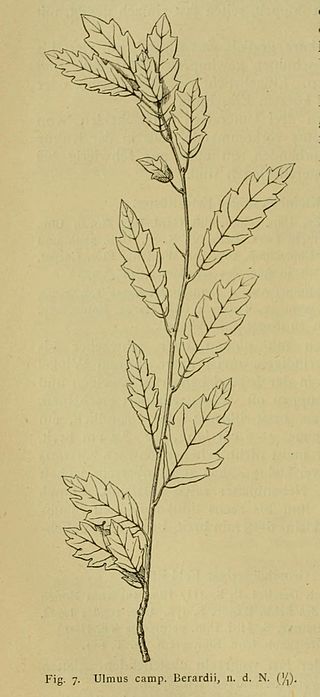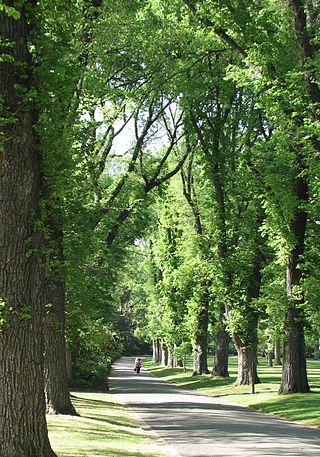
The field elm cultivar Ulmus minor 'Stricta', known as Cornish elm, was commonly found in South West England, Brittany, and south-west Ireland, until the arrival of Dutch elm disease in the late 1960s. The origin of Cornish elm in the south-west of Britain remains a matter of contention. It is commonly assumed to have been introduced from Brittany. It is also considered possible that the tree may have survived the ice ages on lands to the south of Cornwall long since lost to the sea. Henry thought it "probably native in the south of Ireland". Dr Max Coleman of Royal Botanic Garden Edinburgh, arguing in his 2002 paper on British elms that there was no clear distinction between species and subspecies, suggested that known or suspected clones of Ulmus minor, once cultivated and named, should be treated as cultivars, preferred the designation U. minor 'Stricta' to Ulmus minor var. stricta. The DNA of 'Stricta' has been investigated and the cultivar is now known to be a clone.

The Field Elm cultivar Ulmus minor 'Sarniensis', known variously as Guernsey elm, Jersey elm, Wheatley elm, or Southampton elm, was first described by MacCulloch in 1815 from trees on Guernsey, and was planted in the Royal Horticultural Society's gardens in the 1820s. It was listed in the Loddiges catalogue of 1836 as Ulmus sarniensis and by Loudon in Hortus lignosus londinensis (1838) as U. campestris var. sarniensis. The origin of the tree remains obscure; Richens believed it "a mutant of a French population of Field elm", noting that "elms of similar leaf-form occur in Cotentin and in northern Brittany. They vary much in habit but some have a tendency to pyramidal growth. Whether the distinctive habit first developed on the mainland or in Guernsey is uncertain."

The hybrid elm cultivar Ulmus × hollandica 'Wredei', also known as Ulmus × hollandica 'Dampieri Aurea' and sometimes marketed as Golden Elm, originated as a sport of the cultivar 'Dampieri' at the Alt-Geltow Arboretum, near Potsdam, Germany, in 1875.

The Wych Elm cultivar Ulmus glabra 'Lutescens', commonly known as the Golden Wych Elm, arose as a sort of a wych found in the York area in the early 19th century by W. Pontey of Pontey's nursery, Kirkheaton, Huddersfield, who propagated and distributed it. The original tree he named the Gallows Elm for its proximity to a gallows near York. Loudon in The Gardener's Magazine (1839) identified it as a form of Ulmus montana, adding 'Lutescens' by analogy with Corstorphine sycamore, Acer pseudoplatanus 'Lutescens'.

Ulmus 'Exoniensis', the Exeter elm, was discovered near Exeter, England, in 1826, and propagated by the Ford & Please nursery in that city. Traditionally believed to be a cultivar of the Wych Elm U. glabra, its fastigiate shape when young, upward-curving tracery, small samarae and leaves, late leaf-flush and late leaf-fall, taken with its south-west England provenance, suggest a link with the Cornish Elm, which shares these characteristics. The seed, however, is on the stalk side of the samara, a feature of wych elm and its cultivars, whereas in hybrids it would be displaced towards the notch.

The Field Elm cultivar Ulmus minor 'Viminalis Aurea', probably a "golden" form of Ulmus minor 'Viminalis', was raised before 1866 by Egide Rosseels of Louvain, who was known to have supplied 'Viminalis'.
The Field Elm cultivar Ulmus minor 'Viminalis Marginata', a variegated form of Ulmus minor 'Viminalis', was first listed as Ulmus campestris var. viminalis marginataHort. by Kirchner in 1864. Both Van Houtte and Späth marketed an U. campestris viminalis marginata in the late 19th century.

The elm cultivar Ulmus 'Purpurea', the purple-leaved elm, was listed and described as Ulmus Stricta Purpurea, the 'Upright Purpled-leaved Elm', by John Frederick Wood, F.H.S., in The Midland Florist and Suburban Horticulturist (1851), as Ulmus purpureaHort. by Wesmael (1863), and as Ulmus campestris var. purpurea, syn. Ulmus purpureaHort. by Petzold and Kirchner in Arboretum Muscaviense (1864). Koch's description followed (1872), the various descriptions appearing to tally. Henry (1913) noted that the Ulmus campestris var. purpureaPetz. & Kirchn. grown at Kew as U. montana var. purpurea was "probably of hybrid origin", Ulmus montana being used at the time both for wych elm cultivars and for some of the U. × hollandica group. His description of Kew's U. montana var. purpurea matches that of the commonly-planted 'Purpurea' of the 20th century. His discussion of it (1913) under U. campestris, however, his name for English Elm, may be the reason why 'Purpurea' is sometimes erroneously called U. procera 'Purpurea' (as in USA and Sweden.

The Wych Elm cultivar Ulmus glabra 'Cornuta', in cultivation before 1845 – Fontaine (1968) gives its provenance as France, 1835 – is a little-known tree, finally identified as a cultivar of U. glabra by Boom in Nederlandse Dendrologie 1: 157, 1959.

The elm cultivar Ulmus 'Crispa' [:'curled', the leaf margin], sometimes known as the Fernleaf Elm, arose before 1800 and was first listed by Willdenow as U. crispa (1809). Audibert listed an U. campestrisLinn. 'Crispa', orme à feuilles crépues [:'frizzy-leaved elm'], in 1817, and an Ulmus urticaefolia [:'nettle-leaved elm'] in 1832; the latter is usually taken to be a synonym. Loudon considered the tree a variety of U. montana (1838). In the 19th century, Ulmus × hollandica cultivars, as well as those of Wych Elm, were often grouped under Ulmus montana. Elwes and Henry (1913) listed 'Crispa' as a form of wych elm, but made no mention of the non-wych samara.

The putative hybrid cultivar Ulmus × hollandica 'Serpentina' is an elm of unknown provenance and doubtful status. Henry identified it as intermediate between U. glabra and U. minor, a view accepted by Bean and by Melville, who believed that the specimens at Kew bearing the name 'Serpentina' were U. glabra "introgressed by U. carpinifolia" [: U. minor] and were similar to but "distinct from 'Camperdownii'".

The elm cultivar Ulmus 'Berardii', Berard's Elm, was raised in 1865, as Ulmus Berardi, from seeds collected from large specimens of "common elm" growing on the ramparts at Metz, by an employee of the Simon-Louis nursery named Bérard. Carrière (1887), the Späth nursery of Berlin and the Van Houtte nursery of Gentbrugge regarded it as form of a Field Elm, listing it as U. campestris Berardii, the name used by Henry. Cheal's nursery of Crawley distributed it as Ulmus nitens [:Ulmus minor] 'Berardii'. Smith's of Worcester preferred the original, non-specific name, Ulmus 'Berardii'.

The dwarf wych elm cultivar Ulmus glabra 'Nana', a very slow growing shrub that with time forms a small tree, is of unknown origin. It was listed in the Simon-Louis 1869 catalogue as Ulmus montana nana. Henry (1913), referring his readers to an account of the Kew specimen in the journal Woods and Forests, 1884, suggested that it may have originated from a witch's broom. It is usually classified as a form of Ulmus glabra and is known widely as the 'Dwarf Wych Elm'. However, the ancestry of 'Nana' has been disputed in more recent years, Melville considering the specimen once grown at Kew to have been a cultivar of Ulmus × hollandica.

Ulmus 'Louis van Houtte' is believed to have been first cultivated in Ghent, Belgium circa 1863. It was first mentioned by Franz Deegen in 1886. It was once thought a cultivar of English Elm Ulmus minor 'Atinia', though this derivation has long been questioned; W. J. Bean called it "an elm of uncertain status". Its dissimilarity from the type and its Belgian provenance make the 'Atinia' attribution unlikely. Fontaine (1968) considered it probably a form of U. × hollandica.

The Field Elm cultivar Ulmus minor 'Viminalis Pulverulenta' (:'powdery'), also known as 'Viminalis Variegata', a variegated form of U. minor 'Viminalis', was first mentioned by Dieck, in 1885 as U. scabra viminalis pulverulentaHort., but without description. Nursery, arboretum, and herbarium specimens confirm that this cultivar was sometimes regarded as synonymous with U. minor 'Viminalis Marginata', first listed in 1864, which is variegated mostly on the leaf margin. It is likely, however, that 'Pulverulenta' was the U. 'Viminalis Variegata', Variegated Twiggy-branched elm, that was listed and described by John Frederick Wood, F.H.S., in The Midland Florist and Suburban Horticulturist 1847 and 1851, pre-dating both Kirchner and Dieck. Wood did not specify the nature of the variegation.

The Siberian elm cultivar Ulmus pumila 'Pinnato-ramosa' was raised by Georg Dieck, as Ulmus pinnato-ramosa, at the National Arboretum, Zöschen, Germany, from seed collected for him circa 1890 in the Ili valley, Turkestan by the lawyer and amateur naturalist Vladislav E. Niedzwiecki while in exile there. Litvinov (1908) treated it as a variety of Siberian elm, U. pumilavar.arborea but this taxon was ultimately rejected by Green, who sank the tree as a cultivar: "in modern terms, it does not warrant recognition at this rank but is a variant of U. pumila maintained and known only in cultivation, and therefore best treated as a cultivar". Herbarium specimens confirm that trees in cultivation in the 20th century as U. pumilaL. var. arboreaLitv. were no different from 'Pinnato-ramosa'.

The cultivation of elms in Australia began in the first half of the 19th century, when British settlers imported species and cultivars from their former homelands. Owing to the demise of elms in the northern hemisphere as a result of the Dutch elm disease pandemic, the mature trees in Australia's parks and gardens are now regarded as amongst the most significant in the world.

The field elm cultivar Ulmus minor 'Viminalis' (:'willow-like'), occasionally referred to as the twiggy field elm, was raised by Masters in 1817, and listed in 1831 as U. campestris viminalis, without description. Loudon added a general description in 1838, and the Cambridge University Herbarium acquired a leaf specimen of the tree in 1866. Moss, writing in 1912, said that the Ulmus campestris viminalis from Cambridge University Herbarium was the only elm he thought agreed with the original Plot's elm as illustrated by Dr. Plot in 1677 from specimens growing in an avenue and coppice at Hanwell near Banbury. Elwes and Henry (1913) also considered Loudon's Ulmus campestris viminalis to be Dr Plot's elm. Its 19th-century name, U. campestris var. viminalis, led the cultivar to be classified for a time as a variety of English Elm. On the Continent, 'Viminalis' was the Ulmus antarcticaHort., 'zierliche Ulme' [:'dainty elm'] of Kirchner's Arboretum Muscaviense (1864).

The Field Elm cultivar Ulmus minor 'Monumentalis', the tomb elm (Grabmal-Rüster), was raised as a sucker of U. suberosa by Sebastian Rinz, the city gardener of Frankfurt, before 1855 and listed by the Jacob-Makoy nursery of Liège in their 1861 catalogue as Ulmus monumentalisRinz, "a new variety". Kirchner (1864) described it, confirming that it had only recently been propagated by Rinz and established in the nursery. It was distributed from the 1880s by the Baudriller nursery, Angers, and by the Späth nursery, Berlin, as U. campestris monumentalisRinz., appearing separately in their catalogues from U. minor 'Sarniensis', the Guernsey or Wheatley Elm, with which, according to Henry, it was confused on the continent. Krüssmann, for example, gives 'Monumentalis' as a synonym of 'Sarniensis'. 'Sarniensis' is known as monumentaaliep [:monumental elm] in The Netherlands. Springer noted that the Dutch monumentaaliep was "not the actual monumentaaliep but U. glabraMill.var. Wheatleyi Sim. Louis", and that it "should be renamed U. glabraMill. var. monumentalisHort.(non Rinz)". In England, Smith's of Worcester listed Ulmus monumentalis separately from Ulmus 'Wheatley' in the 1880s.
























